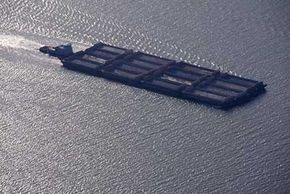By: Yara Simón|Updated: Sep 19, 2023

Boats, from a small toy boat to a cruise ship to a massive cargo ship, manage to stay afloat on water. How do boats float? Archimedes first recorded the standard definition of floating.
The Archimedes Principle states that an object in a fluid experiences an upward force equal to the weight of the fluid displaced by the object. So if a boat weighs 1,000 pounds (or kilograms), it will sink into the water until it has displaced 1,000 pounds (or kilograms) of water. Provided that the boat displaces 1,000 pounds (or kilograms) of water before being submerged, the boat floats. If not, the ship sinks.
Advertisem*nt
It is not very hard to shape a boat in such a way that the weight of the boat has been displaced before the boat is completely underwater. The reason it is so easy is that a good portion of the interior of any boat is air (unlike a cube of steel, which is solid steel throughout). The average density of a boat — the combination of the steel and the air — is very light compared to the average density of water. So very little of the boat actually has to submerge into the water before it has displaced the weight of the boat.
Contents
- How Floating Works
- Why the Titanic Sank
How Floating Works
To better understand why cruise ships and small boats do not sink, we must understand how floating works. How do the water molecules know when 1,000 pounds of them have gotten out of the way? It turns out that the actual act of floating has to do with pressure rather than weight.
If you take a column of water 1 square inch (6.5 square cm) and 1 foot (0.3 m) tall, it weighs about 0.44 pounds (0.2 kg) depending on the temperature of the water (if you take a column of water 1 cm square by 1 meter tall, it weighs about 100 grams). That means that a 1-foot-high column of water exerts 0.44 pounds per square inch (psi). Similarly, a 1-meter-high column of water exerts 9,800 pascals (Pa).
Advertisem*nt

If you were to submerge a box with a pressure gauge attached (as shown in this picture) into water, then the pressure gauge would measure the pressure of the water at the submerged depth:
If you were to submerge the box 1 foot into the water, the gauge would read 0.44 psi (if you submerged it 1 meter, it would read 9,800 Pa). What this means is that the bottom of the box has an upward force being applied to it by that pressure.
So, if the box is 1 foot square and it is submerged 1 foot, the bottom of the box is being pushed up by a water pressure of 63 pounds (12 inches x 12 inches x 0.44 psi). (If the box is 1 meter square and submerged 1 meter deep, the upward force is 9,800 newtons.) This just happens to exactly equal the weight of the cubic foot or cubic meter of water that is displaced!
Gravity exerts a downward force on the boat, attempting to pull it down into the water. To remain afloat, the boat must create an upward force that is equal to or greater than its weight. It is this upward water pressure pushing on the bottom of the boat that is causing the boat to float.
Each square inch (or square centimeter) of the boat that is underwater has water pressure pushing it upward, and this combined pressure lets ships float.
Advertisem*nt
Why the Titanic Sank
At more than 800 feet (243 meters), the Titanic, often referred to as "unsinkable," was not as big as a modern container ship. But despite the highly advanced technology used on the ship, it tragically sank on its maiden voyage in April 1912.
Several factors contributed to the ship's sinking, notably the damage caused to the ship after it struck an iceberg. The ship's designers included 16 watertight compartments so the boat could float even if damaged. However, as the compartments filled with water, the ship's overall density increased.
Advertisem*nt
When the density of an object becomes greater than the density of the fluid it displaces (in this case, seawater), it loses buoyancy. The flooding of multiple compartments caused the Titanic to become denser than the surrounding seawater.
Can a Ship Be Too Big to Float?
Mostly, a boat sinks because its buoyancy cannot support its weight and cargo. But size alone doesn't determine a boat's ability to float. We have to also factor in the boat's design, construction, distribution, and operation. Regardless of its size and what moves the boat forward, a poorly designed ship is more susceptible to sinking.
It's important to note that large commercial vessels, such as cargo ships and cruise liners, are subject to stringent safety regulations and inspections to ensure their seaworthiness and stability. However, no floating boats are entirely immune to the risk of sinking if it encounters extreme conditions, is poorly maintained, or exceeds its operational limits. Proper design, construction, maintenance, and operation are essential for the safety of large boats at sea.
This article was updated in conjunction with AI technology, then fact-checked and edited by a HowStuffWorks editor.
Advertisem*nt
Lots More Information
Related HowStuffWorks Articles
- How Floating Cities Will Work
- How Helium Balloons Work
- Would a Balloon Filled With Vacuum Instead of Helium Float?
- How Cruises Work
- How Submarines Work
More Great Links
Cite This!
Please copy/paste the following text to properly cite this HowStuffWorks.com article:
Citation
Advertisem*nt
Advertisem*nt
Loading...
`;t.byline_authors_html&&(e+=`By: ${t.byline_authors_html}`),t.byline_authors_html&&t.byline_date_html&&(e+="|"),t.byline_date_html&&(e+=t.byline_date_html);var i=t.body_html.replaceAll('"pt','"pt'+t.id+"_");return e+=`\n\t\t\t\t
As an expert in physics and engineering with a specialization in fluid dynamics and buoyancy, I have a comprehensive understanding of the principles that govern objects' floating and sinking behaviors in fluids. My expertise extends to the application of Archimedes' principle, water pressure, buoyant force, and the factors influencing a vessel's ability to float.
In the article discussing boats and their ability to float, several fundamental concepts rooted in physics and engineering are highlighted:
-
Archimedes' Principle: This principle states that an object immersed in a fluid experiences an upward force equal to the weight of the fluid displaced by the object. This principle determines whether a boat floats or sinks based on the balance of the boat's weight and the weight of the water it displaces.
-
Buoyancy and Density: The buoyant force exerted by water on a submerged object is equal to the weight of the water displaced. A boat can stay afloat when the combined density of the boat (including air inside) is lower than that of water.
-
Water Pressure and Floating: The pressure exerted by water increases with depth. The upward force acting on the submerged part of a boat is due to the difference in pressure between the top and bottom of the boat, which counteracts gravity and enables flotation.
-
Factors Affecting Flotation: The design, construction, and distribution of weight within a boat significantly influence its ability to float. The Titanic's sinking, despite its advanced design, was caused by the increase in density when its compartments filled with water, surpassing the density of seawater.
-
Limitations of Size: While size isn't the sole determinant of a boat's ability to float, poor design, maintenance, or exceeding operational limits can jeopardize even large vessels' buoyancy and safety.
-
Safety Regulations: Large commercial vessels undergo rigorous inspections and adhere to stringent safety regulations to ensure their stability and seaworthiness. However, extreme conditions or neglect can compromise even well-designed ships.
The article emphasizes the interplay between various factors that contribute to a boat's ability to stay afloat, including the physics of buoyancy, design considerations, and real-world examples such as the Titanic's tragic sinking.